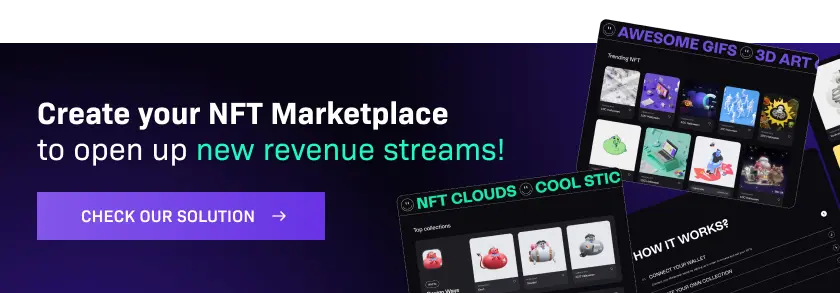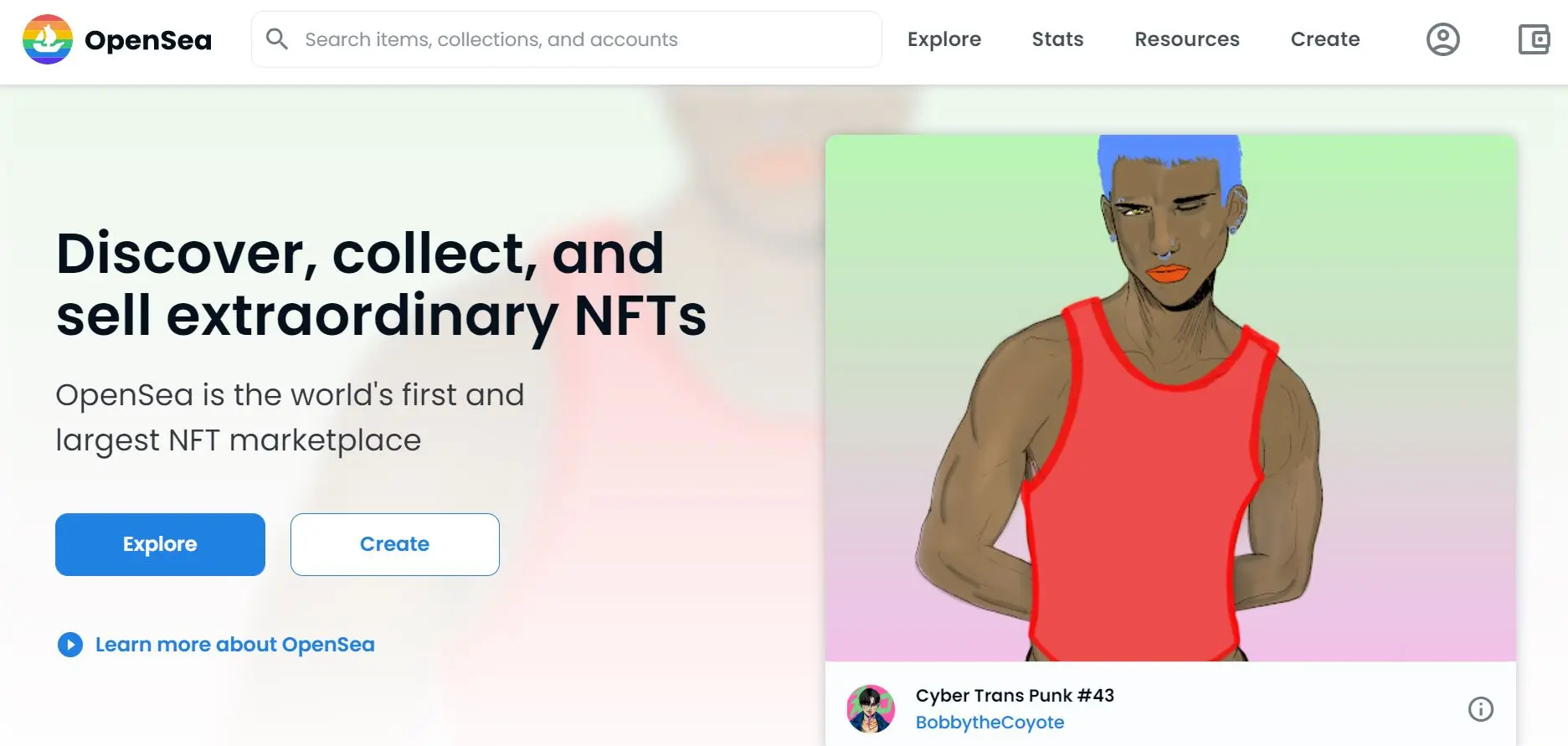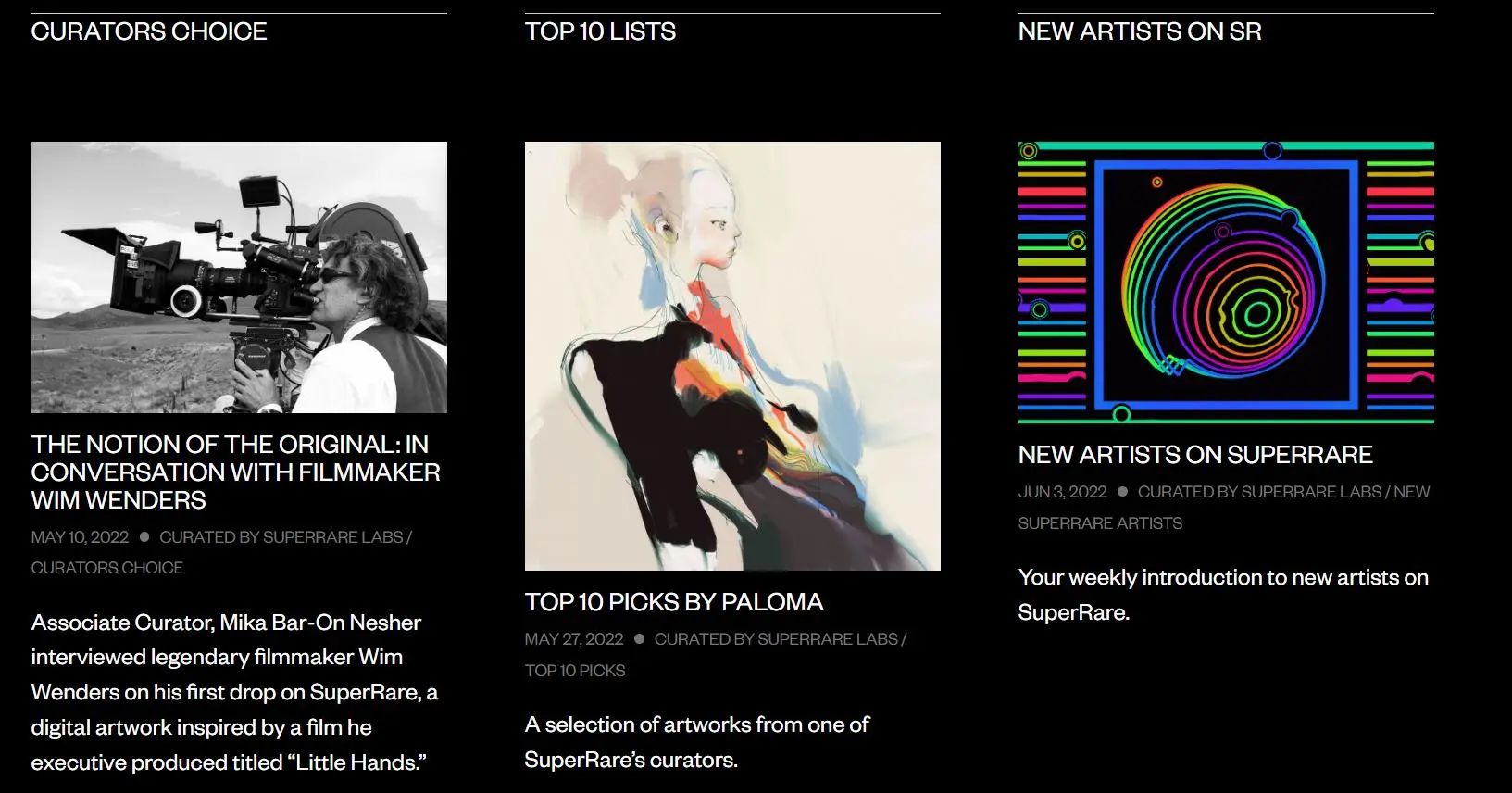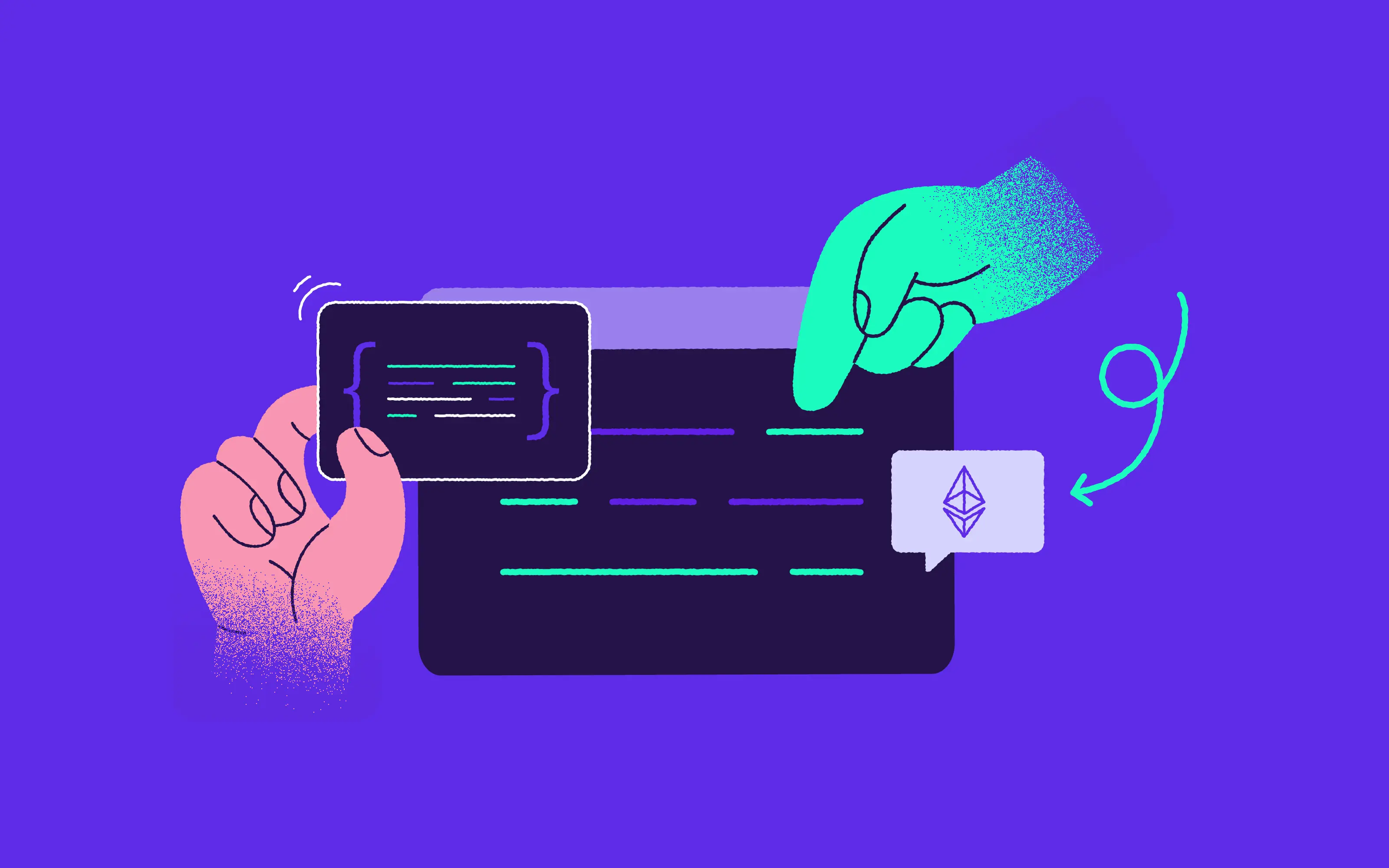
By now most of us have heard about the meteoric rise of NFTs. This time last year, we wrote about how they were taking the digital world by storm, with all their ups and downs. The figures speak for themselves - the NFT space has grown tenfold in the space of two years. It’s a true emerging market, with huge future growth potential. The added bonus lies in its decentralized nature, which means that if you’re a marketplace owner, there’s relatively little involvement on your part when it comes to trading. Your transactions are recorded on the blockchain, thereby reducing risk.
Did you know that OpenSea (which we describe in more detail below) is the only unicorn among NFT startups. Founded just over 4 years ago, it has recently been valued at $13 billion. Could your marketplace be next? Today, we wanted to recap the essential NFT facts and figures, and to explore the concept of the NFT marketplace, and how you might go about building one.

What are NFTs?
Non-fungible tokens (NFTs) are pieces of information with unique identity and ownership written on the blockchain, to which we can attach a digital file. The word ‘fungible’ in economics is an asset with units that are easily interchangeable, like money. But something that is non-fungible possesses unique properties, which means that it cannot be interchanged.
To put it more simply, NFTs are unique digital assets that can be bought and sold just like any other items, but they have no physical form. You might think of these digital tokens as certificates of ownership for such assets - almost like an autograph which proves authenticity.
What is an NFT marketplace?
NFT marketplace is a digital platform where you can buy and sell NFTs. There are many such marketplaces in existence, each covering a different niche in the NFT market. They have sometimes been described as the ‘Amazon of the digital world.’ If you’re looking to build your own, it’s a good idea to first get to grips with what users consider when selecting a marketplace to purchase from.

Dashboard of OpenSea, the largest NFT marketplace
Examples of the best NFT marketplaces
Below are three popular marketplaces which have experienced particularly rapid growth over the last couple of years.
1. OpenSea
OpenSea is the world’s largest NFT marketplace and also the first to be founded, back in late 2017. Interestingly, it began life as a marketplace for CryptoKitties but has since expanded beyond collectibles.
The marketplace supports the use of Ethereum, Solana, Klaytn and Polygon; with a range of cryptocurrencies accepted as payment options. Unlike other NFT marketplaces, including Rarible, it doesn’t support the use of fiat currency. OpenSea charges a fee of 2.5% for every transaction. Additionally, the user pays the gas fee for the blockchain transaction.
OpenSea is one of the best NFT marketplaces for newcomers. It has published a beginner’s guide which gives users an easy explanation of essentials, NFT trading, and how the platform works.
2. Rarible
Rarible is an Ethereum-based platform that allows users to buy and sell digital artwork, collectibles, video game assets and NFTs. It was founded in 2020, and already boasts roughly $16 million in venture capital from firms like CoinFund and Coinbase Ventures. It has also expanded to cover a user base of more than 1.5 million.
Rarible has created its own native token called RARI, and its holders are allowed to vote on company decisions, including policy changes. It charges a flat 2.5% fee on every transaction, plus any gas fees. It allows the purchase of digital assets using a credit card, and in doing so, supports transactions in fiat currencies.
Rarible is a good choice of NFT marketplace for those who want access o a broad network with strong connections.
3. SuperRare
SuperRare is a high-end marketplace for creative work which presents itself as a digital art gallery. It’s highly selective with the types of NFTs that it features on its platform and spends a considerable amount of time reviewing applications from digital creators, before making NFTs ready for sale, thereby giving a greater assurance of quality. SuperRare charges 15% the first time an NFT is sold on the primary market, alongside a flat 3% charge for every transaction.
The platform has recently announced the release of its SuperRare curation token. With $RARE, users can influence the diversification of the platform’s art ecosystem. SuperRare is highly popular among seasoned collectors of digital art.
Pro Tip: Consider user motivation before creating your NFT marketplace
As with any digital product, the most important element are your users. It’s worth considering what is likely to govern their choices. It is them you create an NFT marketplace for. Here are three top factors.
The type of digital asset they’re interested in
Almost anything in the digital world can be tokenized on the blockchain. When we talk about an NFT product, we naturally think about digital art. The need to create NFT art rules this world, but NFTs can also come in the form of a written piece of content, a film, a video game or a collector’s item of another kind. Bear in mind that if you want your NFT marketplace work wonders as a community platform, you can also link merchandise with blockchain-proved ownership, as is the case with Uniqly.io. It’s worth considering early on how broad or specific you want your marketplace to be.
The tokens supported on the marketplace
Most NFT marketplaces support a wide variety of tokens, whereas the more niche ones are closed and use a specific proprietary token. Again, it’s important to decide early on which way you want to go, as this will likely determine your target audience. Marketplace users might be interested in a multi-chain NFT marketplace, where anyone can sell and buy popular NFT pieces through a broad range of means. Depending on what type of marketplace transfers you allow, the volume of NFT and number of users willing to connect their digital wallet will likely differ. Remember that every new user opening up an account on your marketplace will need to make sure that they’ve funded their blockchain wallet with the right token required to participate.

Rarible's options for wallet connection
The level of security in the marketplace
Security is paramount when it comes to transactions on a marketplace, and users often conduct research into whether there have been any security breaches on a given marketplace in the past. That’s why focusing on security from the outset is the key to success if you want to create your own NFT marketplace, and we’ll go into more detail on this in a separate blog post.
What is a white-label NFT marketplace?
In a nutshell, a white-label product or service is one that is produced by a specific company for use by other companies, who incorporate their own brand into it. A white-label marketplace essentially has all the backend and frontend of the marketplace already set up, meaning that a company can add it’s own branding and UI, create NFT collection and quickly get started.
It’s also worth remembering that a white-label marketplace is merely a foundation for further customization, meaning that new features and functionality can always be added at a later stage.
» Read more: Developing your NFT marketplace - why discovery phase is key?
The core components of a white-label NFT marketplace in 2023
Below are the must-have features that every NFT marketplace development process should include:
The Storefront - This is the first thing that users see when they access your platform. It should hold information about bids, owners, price history and other key information about buying and selling NFTs.
The Crypto Wallet - It’s paramount that your users have a safe and secure space in which to store and submit their tokens. Make ease of use a priority by offering a connected, ‘native’ wallet, rather than asking them to sign up via external wallets.
The Auction - Your NFT marketplace should give users the option to buy and sell NFTs and to bid on them. Don’t forget all the elements that are crucial to the ‘auction’ functionality, such as the date and time that the bidding closes, buyer information about the status of their bids, and an auction watchlist.
An NFT Search - Make it easy for your users to find the NFTs that they’re looking for, through a handy search bar. At the same time it’s great to have a search menu that is listed by categories, such as videos, memes, art, music and other NFTs - to give users an at-a-glance indication of where to browse.
Filters - Similar to the ‘search’ function above, filters on an NFT marketplace allow items to be found easily. Be sure to include multiple relevant filters, including those related to price, best sellers, new items and top deals.
Listings - Give your users the ability to send and create collectibles if needed. The best way to do so would be to create a page on which they can provide a file and fill in the relevant information, including things such as title description and tags.
Ratings - This feature is mainly useful to those users who are new to the platform. As they’re likely to have little knowledge of how NFTs work and their value, seeing what other users think about a particular seller’s reliability is particularly handy. The highest ranked users are rewarded for their efforts through increased views of their product.
The demand for an NFT marketplace that brings a good feature set is growing. Depending on your business model, only then will you be able to create a niche for your NFT developers, where users can create their own collectibles that stick out.

SuperRare's ratings
What are the steps to make a white-labeled NFT marketplace platform work?
Below are the top workflow elements of our step-by-step guide for co-building a white-label NFT marketplace with our developers.
Selection of the right blockchain technology
A white-labeled NFT marketplace can be built on a number of blockchains, including Binance Smart Chain, Ethereum, Polygon, Solana or others.
UI Development
Top NFT marketplaces have a clean UI that makes it easy for users to navigate the platform. Alongside an intuitive interface, you might choose to include sign-posts or tutorials which would be beneficial to first time users.
The Coding of Smart Contracts
Smart contracts are the core component of any transactions on the marketplace, and are integral to its security. If you’d like to read up more about how they work, take a look at our complete Guide to Smart Contract Security.
Integration of IPFS Storage
IPFS is a distributed system for storing and accessing files, websites, applications, and data - and it’s important for storing all the NFTs in your NFT marketplace. DB storage on the other hand, is used for storing user data.
Backend and Frontend Integration
The crucial final step of development is the integration of the frontend and backend, as well as the IPFS and DB storage.
Beta Testing
The NFT platform is always tested on the Testnet to identify vulnerabilities and to fix any bugs before deployment.
Deployment in the client’s environment
You may choose to release the beta version for selected users to feed back on before you launch an NFT marketplace globally.
Make an NFT marketplace for the users
Remember that if you decide to build an NFT market that sells, welcome a specific group of people. Their composition can change as your NFT project grows, but at all times the development of NFT marketplaces should base on existing demand, even if it means building for users who not necessarily like art. NFT owners might care for making a unique identifier for each NFT that extends the token itself. The demand for NFT marketplace that brings value through its very design won't be uncommon. Aim not for software development, but great experiences.
Get ready to build your own NFT marketplace quickly and easily
If you have a strong concept to build an NFT marketplace from scratch, and are not sure how to create a unique global NFT market, our team can help. Our developers have solid experience to help you develop an NFT marketplace; our UX team is deeply dedicated to delivering a stellar user experience, while our design team can create amazing illustrations which turn the entire white-labeled platform into something that truly reflects your unique brand. Just let us know what your marketplace idea is.



